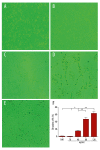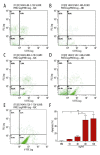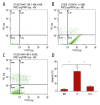Heroin activates ATF3 and CytC via c-Jun N-terminal kinase pathways to mediate neuronal apoptosis
- PMID: 25848832
- PMCID: PMC4400970
- DOI: 10.12659/MSMBR.893827
Heroin activates ATF3 and CytC via c-Jun N-terminal kinase pathways to mediate neuronal apoptosis
Abstract
BACKGROUND Drug abuse and addiction has become a major public health problem that impacts all societies. The use of heroin may cause spongiform leukoencephalopathy (SLE). MATERIAL AND METHODS Cerebellar granule cells were derived from 7-day-old Sprague-Dawley rat pups. Neurons were dissociated from freshly dissected cerebella by mechanical disruption in the presence of 0.125% trypsin and DNaseI and then seeded at a density of 4×10^6 cells/ml in Dulbecco's modified Eagle's medium/nutrient mixture F-12 ham's containing 10% fetal bovine serum and Arc-C(sigma) at concentrations to inhibit glial cell growth inoculated into 6-well plates and a small dish. RESULTS We found that heroin induces the apoptosis of primary cultured cerebellar granule cells (CGCS) and that the c-Jun N-terminal kinase (JNK) pathway was activated under heroin treatment and stimulated obvious increases in the levels of C-jun, Cytc, and ATF3mRNA. CYTC and ATF3 were identified as candidate targets of the JNK/c-Jun pathway in this process because the specificity inhibitors SP600125 of JNK/C-jun pathways reduced the levels of C-jun, Cytc, and ATF3mRNA. The results suggested that SP600125 of JNK/C-jun can inhibit heroin-induced apoptosis of neurons. CONCLUSIONS The present study analyzes our understanding of the critical role of the JNK pathway in the process of neuronal apoptosis induced by heroin, and suggests a new and effective strategy to treat SLE.
Figures





Similar articles
-
Heroin activates Bim via c-Jun N-terminal kinase/c-Jun pathway to mediate neuronal apoptosis.Neuroscience. 2013 Mar 13;233:1-8. doi: 10.1016/j.neuroscience.2012.12.005. Epub 2012 Dec 20. Neuroscience. 2013. PMID: 23262244
-
Activating transcription factor 3 up-regulated by c-Jun NH(2)-terminal kinase/c-Jun contributes to apoptosis induced by potassium deprivation in cerebellar granule neurons.Neuroscience. 2008 Feb 6;151(3):771-9. doi: 10.1016/j.neuroscience.2007.10.057. Epub 2007 Dec 4. Neuroscience. 2008. PMID: 18178318
-
Activation of caspase-3 and c-Jun NH2-terminal kinase signaling pathways involving heroin-induced neuronal apoptosis.Neurosci Lett. 2011 Sep 20;502(3):209-13. doi: 10.1016/j.neulet.2011.07.046. Epub 2011 Aug 10. Neurosci Lett. 2011. PMID: 21856377
-
The role of mitogen-activated protein kinase in cadmium-induced primary rat cerebral cortical neurons apoptosis via a mitochondrial apoptotic pathway.J Trace Elem Med Biol. 2015 Jan;29:275-83. doi: 10.1016/j.jtemb.2014.06.006. Epub 2014 Jun 24. J Trace Elem Med Biol. 2015. PMID: 25043952
-
Cerebellar neuronal apoptosis in heroin-addicted rats and its molecular mechanism.Int J Clin Exp Pathol. 2015 Jul 1;8(7):8260-7. eCollection 2015. Int J Clin Exp Pathol. 2015. PMID: 26339395 Free PMC article.
Cited by
-
Influence of Tanshinone IIA on apoptosis of human esophageal carcinoma Eca-109 cells and its molecular mechanism.Thorac Cancer. 2017 Jul;8(4):296-303. doi: 10.1111/1759-7714.12441. Epub 2017 Apr 13. Thorac Cancer. 2017. PMID: 28407361 Free PMC article.
-
Partial Recovery in Toxic Leukoencephalopathy: Is It Really a Slow Improvement or a Warning Sign?Cureus. 2023 Aug 4;15(8):e42966. doi: 10.7759/cureus.42966. eCollection 2023 Aug. Cureus. 2023. PMID: 37667711 Free PMC article.
-
Molecular Mechanism of the Regulatory Effect of Schisandrol A on the Immune Function of Mice Based on a Transcription Factor Regulatory Network.Front Pharmacol. 2021 Dec 20;12:785353. doi: 10.3389/fphar.2021.785353. eCollection 2021. Front Pharmacol. 2021. PMID: 34987399 Free PMC article.
-
Berberine Restricts Coxsackievirus B Type 3 Replication via Inhibition of c-Jun N-Terminal Kinase (JNK) and p38 MAPK Activation In Vitro.Med Sci Monit. 2017 Mar 25;23:1448-1455. doi: 10.12659/msm.899804. Med Sci Monit. 2017. PMID: 28341822 Free PMC article.
-
A small molecule induces integrin β4 nuclear translocation and apoptosis selectively in cancer cells with high expression of integrin β4.Oncotarget. 2016 Mar 29;7(13):16282-96. doi: 10.18632/oncotarget.7646. Oncotarget. 2016. PMID: 26918348 Free PMC article.
References
-
- Jordan MT, Bryant SM, Aks SE, et al. A five-year review of the medical outcome of heroin body stuffers. J Emerg Med. 2009;36(3):250–56. - PubMed
-
- Nutt D, King LA, Saulsbury W, et al. Development of a rational scale to assess the harm of drugs of potential misuse. Lancet. 2007;369(9566):1047–53. - PubMed
-
- Di Chiara G, Bassareo V. Reward system and addiction: what dopamine does and doesn’t do. Curr Opin Pharmacol. 2007;7(1):69–76. - PubMed
-
- Büttner A, Mall G, Penning R, et al. The neuropathology of heroin abuse. Forensic Sci Int. 2000;113(1–3):435–42. - PubMed
-
- Vassilev LT, Vu BT, Graves B, et al. In vivo activation of the p53 pathway by small-molecule antagonists of MDM2. Science. 2004;303(5659):844–48. - PubMed
MeSH terms
Substances
LinkOut - more resources
Full Text Sources
Molecular Biology Databases
Research Materials
Miscellaneous

